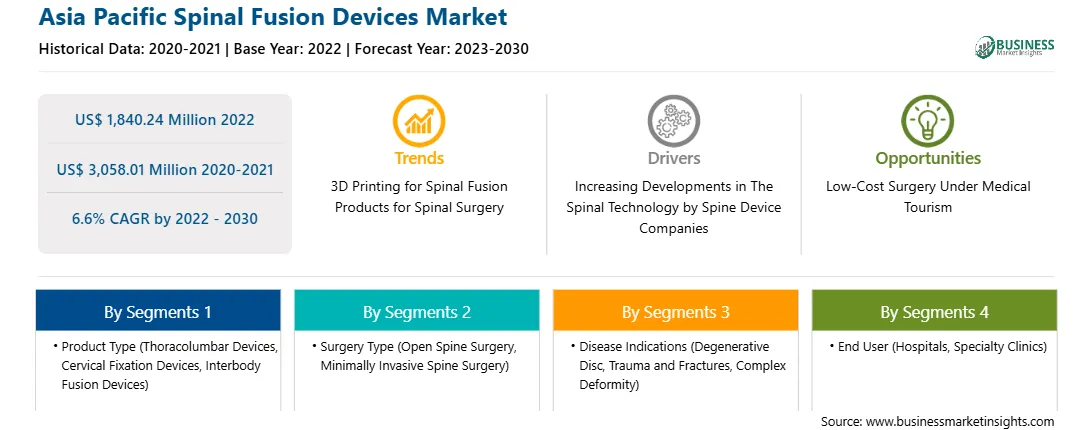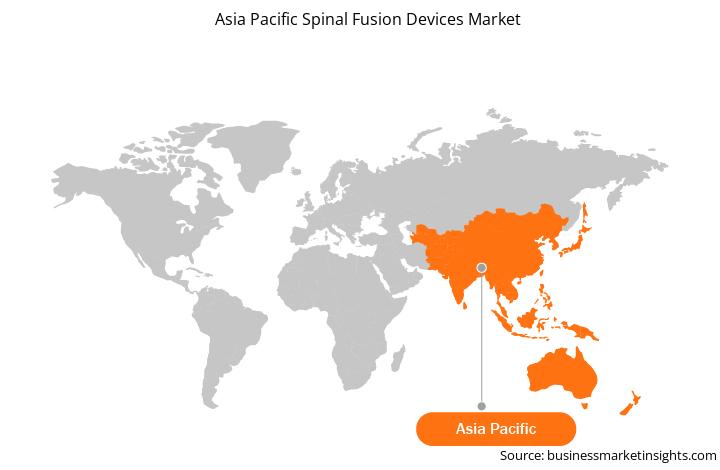Spinal fusion surgeries are much costlier; many patients slide back from the decision to undergo spinal surgeries. Also, in many cases, the cost of spinal implants is not covered under health insurance plans, limiting the number of surgeries. On the other hand, medical tourism has enabled to offer spinal fusion surgeries at cheaper costs. Countries in developing regions have significantly developed medical tourism and have advanced technologies that provide world-class medical services at cheaper rates. In India, it is nearly between US$ 8000 and US$ 12,000. Also, the cost of thoracoplasty in India is between US$ 2,500 and US$ 4,000. Offering critical surgeries at cheaper costs increases patient flow to these countries for their medical treatments. Also, the availability of advanced medical techniques and increasing government funding to increase medical tourism are leading to the increasing demand for advanced surgical implants. Further, the advancing healthcare infrastructure in developing countries will likely continue the demand for advanced medical devices, enhancing growth opportunities for the Asia Pacific spinal fusion devices market.
The government of China has introduced various policies to support the development of the medical devices, including the spine surgery devices. These policies aim to improve product quality, promote domestic manufacturing, and ensure patient safety. Additionally, the government has been working on healthcare reforms to enhance access to healthcare services, which indirectly benefits the spine market by increasing the number of patients seeking treatment. The Chinese market has its own regulatory environment and unique considerations. Companies are focusing to enter the Chinese spinal surgery devices market. These companies need to comply with the country’s regulatory requirements, including registration and approval processes. For instance, in June 2023, the technical guidelines for clinical evaluation of spinal fusion devices were issued by National Medical Products Administration (NMPA) and according to these guidelines spinal fusion devices were categorized under Class III medical devices.
Moreover, with the increasing technological advancements and product innovations, mid-size to smaller companies’ are increasing their market presence by introducing new technologies with better usability. For instance, in March 2021, Chinese authorities issued an approval for orthopedic surgical robot which carried out a spinal fusion surgery and a discectomy in a patient in Shenzhen.
The Asia Pacific spinal fusion devices market is segmented based on product type, surgery type, disease indications, end user, and country.
Based on product type, the Asia Pacific spinal fusion devices market is segmented into thoracolumbar devices, cervical fixation devices, and interbody fusion devices. The thoracolumbar devices segment held the largest share in 2022.
By surgery type, the Asia Pacific spinal fusion devices market is bifurcated into open spine surgery and minimally invasive spine surgery. The open spine surgery segment held the largest share in 2022.
By disease indications, the Asia Pacific spinal fusion devices market is segmented into degenerative disc, trauma and fractures, complex deformity, and others. The degenerative disc segment held the largest share in 2022.
In terms of end users, the Asia Pacific spinal fusion devices market is categorized into hospitals, specialty clinics, and others. The hospitals segment held the largest share in 2022.
Based on country, the Asia Pacific spinal fusion devices market is segmented into China, Japan, India, Australia, South Korea, and the Rest of Asia Pacific. China dominated the Asia Pacific spinal fusion devices market in 2022.
ATEC Spine Inc, B. Braun SE, DePuy Synthes Inc, Globus Medical Inc, Medtronic Plc, NuVasive Inc, Stryker Corp, and ZimVie Inc are some of the leading companies operating in the Asia Pacific spinal fusion devices market.
Strategic insights for the Asia Pacific Spinal Fusion Devices provides data-driven analysis of the industry landscape, including current trends, key players, and regional nuances. These insights offer actionable recommendations, enabling readers to differentiate themselves from competitors by identifying untapped segments or developing unique value propositions. Leveraging data analytics, these insights help industry players anticipate the market shifts, whether investors, manufacturers, or other stakeholders. A future-oriented perspective is essential, helping stakeholders anticipate market shifts and position themselves for long-term success in this dynamic region. Ultimately, effective strategic insights empower readers to make informed decisions that drive profitability and achieve their business objectives within the market.

| Report Attribute | Details |
|---|---|
| Market size in 2022 | US$ 1,840.24 Million |
| Market Size by 2030 | US$ 3,058.01 Million |
| Global CAGR (2022 - 2030) | 6.6% |
| Historical Data | 2020-2021 |
| Forecast period | 2023-2030 |
| Segments Covered |
By Product Type
|
| Regions and Countries Covered | Asia-Pacific
|
| Market leaders and key company profiles |
The geographic scope of the Asia Pacific Spinal Fusion Devices refers to the specific areas in which a business operates and competes. Understanding local distinctions, such as diverse consumer preferences (e.g., demand for specific plug types or battery backup durations), varying economic conditions, and regulatory environments, is crucial for tailoring strategies to specific markets. Businesses can expand their reach by identifying underserved areas or adapting their offerings to meet local demands. A clear market focus allows for more effective resource allocation, targeted marketing campaigns, and better positioning against local competitors, ultimately driving growth in those targeted areas.

The Asia Pacific Spinal Fusion Devices Market is valued at US$ 1,840.24 Million in 2022, it is projected to reach US$ 3,058.01 Million by 2030.
As per our report Asia Pacific Spinal Fusion Devices Market, the market size is valued at US$ 1,840.24 Million in 2022, projecting it to reach US$ 3,058.01 Million by 2030. This translates to a CAGR of approximately 6.6% during the forecast period.
The Asia Pacific Spinal Fusion Devices Market report typically cover these key segments-
The historic period, base year, and forecast period can vary slightly depending on the specific market research report. However, for the Asia Pacific Spinal Fusion Devices Market report:
The Asia Pacific Spinal Fusion Devices Market is populated by several key players, each contributing to its growth and innovation. Some of the major players include:
The Asia Pacific Spinal Fusion Devices Market report is valuable for diverse stakeholders, including:
Essentially, anyone involved in or considering involvement in the Asia Pacific Spinal Fusion Devices Market value chain can benefit from the information contained in a comprehensive market report.